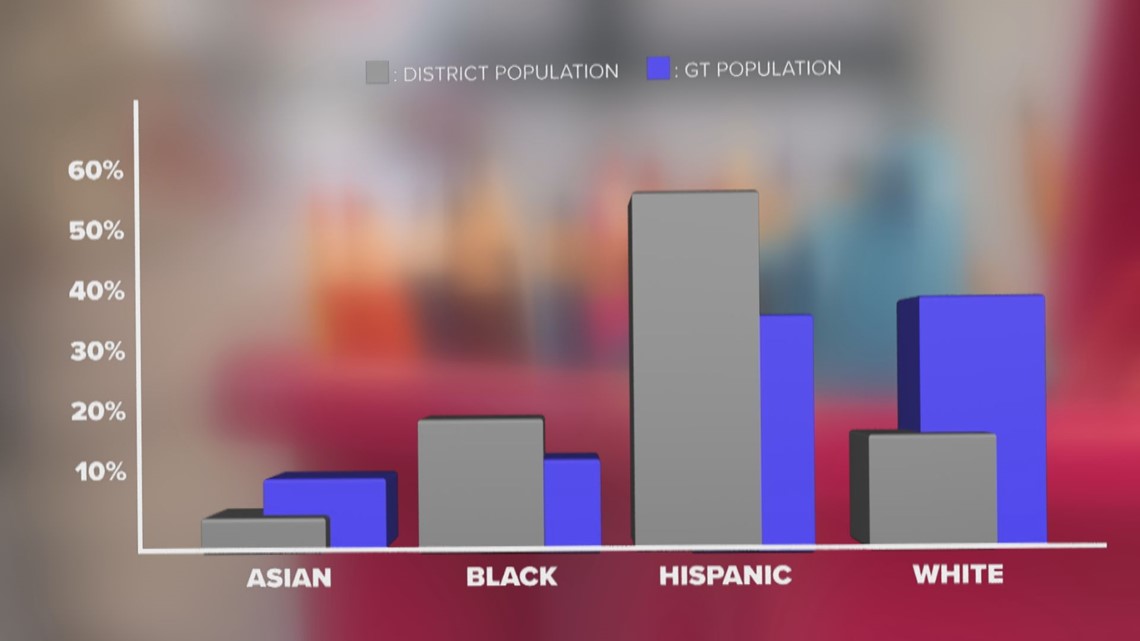AURORA, Colo. — The number of students of color in the Aurora Public School's (APS) Gifted and Talented (GT) program increased 17 percentage points last school year after a new program launched that changed the way gifted students are identified.
Instead of waiting on teachers to recommend students for testing like before, APS tested every student at 10 pilot schools in the district at the end of the 2018-2019 school year using a localized test. Students who scored in the top 5% of that test were identified as GT.
After testing in the 10 pilot schools, GT student demographics changed significantly:
- White representation reduced 10 percentage points.
- Hispanic representation increased 8 percentage points.
- Black representation increased 9 percentage points.
- Asian representation reduced 5 percentage points.
"I was not expecting this equity shift," said APS Gifted Education Coordinator Carol Dallas. "I thought there would be something, but not this dramatic."
The district also found that the numbers included more girls, more immigrants, more English language learners and more free-and-reduced lunch students.
What inspired the change?
For years, the Aurora Public School (APS) district found that the demographics of students in the APS Gifted and Talented (GT) program didn't look like the demographics of the student body as a whole.
APS students come from more than 130 countries and speak more than 160 languages, according to the district. Almost 36% of APS students speak English as a second language. It's a diverse community.
APS district population in January 2019 stood at:
- 15.4% white
- 54.1% Hispanic
- 19.4% black
- 4.8% Asian
"The gifted population should mirror the district demographic," Dallas said.
When APS looked at the numbers, it found white and Asian students and boys were over-represented in gifted education. In contrast, female, Hispanic and black students were under-represented.
APS GT population in January 2019 stood at:
- 36.7% white
- 34.6% Hispanic
- 12.7% Black
- 9% Asian


"For the district, we were about 21% over-represented white, 19% under-represented Hispanic, and I believe about 6% under-represented black," Dallas said. "We knew that needed to change."
Dallas and APS launched the Gifted Education Pilot on Local Norms at the beginning of 2019 in 10 pilot schools in the district:
- Arkansas Elementary
- Clyde Miller P-8
- Jewell Elementary
- Lyn Knoll Elementary
- Montview Elementary
- Murphy Creek P-8
- Peoria Elementary
- Sixth Avenue Elementary
- Tollgate Elementary
- Vassar Elementary
"Our identification system before the pilot was to have a nomination or referral system, and then we would test students using the Cognitive Abilities Test," Dallas said. "We found that there were a large percentage of students that were just slipping through the cracks."
This is the common practice around the country for identifying GT students, an APS spokesperson told 9NEWS. Teachers refer or nominate a student for gifted testing and that student is given the Cognitive Abilities Test (CogAT). CogAT is a multiple-choice K-12 assessment that measures reasoning skills with different types of verbal, quantitative and nonverbal questions.
If the student scores in the 95th percentile or above, they are identified as gifted. This is the process of using “national norms.”
According to APS, the process wasn't producing equitable results in the district because the district's demographics didn't mirror those of the nation as a whole.
What happens now?
"I know these students," Dallas said. "I work with these students, I know their names. When we identify these students and we see positive changes in their lives from that, that’s why I’m in this profession."
The results encouraged Dallas to go to the board of education and district leadership in Aurora in May to ask for 10 more schools to test the pilot program during the first semester of the 2019-2020 school year.
The pilot program will soon launch in 20 schools in the APS district. If the pilot program yields the same kind of results a second time, Dallas will be recommending that the changes go district-wide.
SUGGESTED VIDEOS | Next with Kyle Clark

